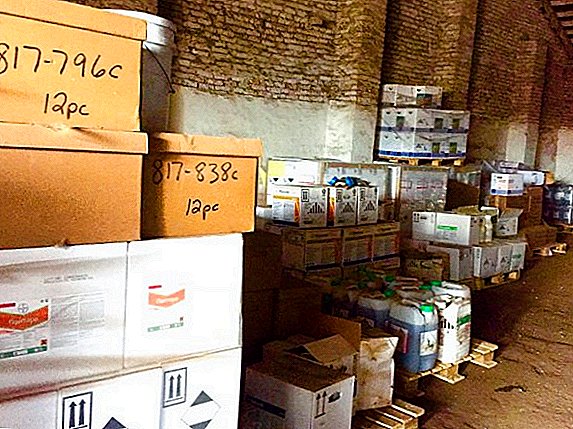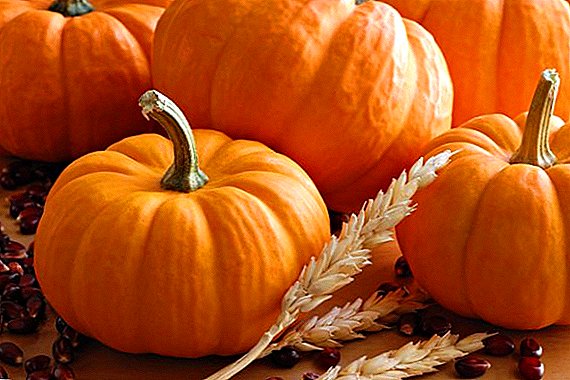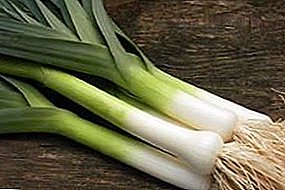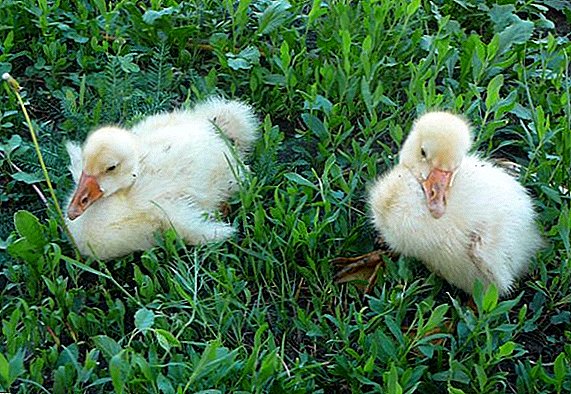 Almost all poultry farmers sooner or later face the problem of the disease of poultry, and often the disease affects the young. Breeders of geese are probably aware of such an unpleasant phenomenon as the fall of a gosling on its feet, which begins with short-term episodes, but later often leads to complete paralysis. Let's look at the main causes of goose cases and preventive measures that prevent it.
Almost all poultry farmers sooner or later face the problem of the disease of poultry, and often the disease affects the young. Breeders of geese are probably aware of such an unpleasant phenomenon as the fall of a gosling on its feet, which begins with short-term episodes, but later often leads to complete paralysis. Let's look at the main causes of goose cases and preventive measures that prevent it.
The reasons
There are a lot of reasons for problems with paws and there is no single explanation for all cases of the fall of the goslings. The development of infectious and viral ailments, the presence of parasites in the body of the bird, vitamin deficiency and even fungal diseases are among the most typical root causes of this phenomenon. 
Consider the features of each problem more closely.
Infectious diseases
Infectious diseases are transmitted to goslings from sick relatives and are often accompanied by a number of other unpleasant symptoms: purulent discharge from the eyes and nose, loss of feathers, etc.
Check out the main diseases of geese.
The most serious infectious diseases veterinarians include the following:
- tuberculosis;
- coccidiosis;
- salmonellosis (paratyphoid);
- Qatar goiter, which is the result of feeding livestock coarse food.
The final diagnosis can only be made by a veterinarian, but in any of these cases, the treatment will be quite long, using antibiotics (ampicillin, tetracycline, chloramphenicol, diluted in drinking water in the proportion of 6 g per 1000 heads of goslings), serum from the blood of an already ill bird (such the method of treatment is rarely observed), as well as drugs supporting the digestive tract of chicks (after 5-7 days of treatment of a sick bird, furan-row preparations are prescribed for 5-7 g per 1000 head). 
The recovery period takes about 1 month, and sometimes more. In the absence of adequate treatment, dead birds no longer rise to their feet and soon die.
Important! Self-treatment of an infectious disease without a precise definition of its nature is not only an unreasonable, but also a dangerous decision, because the condition of the goslings can only be aggravated.
Unfortunately, even after the timely treatment of an infectious disease, not all the chicks are again on their feet. The weakest representatives either die immediately or remain crippled for the rest of their lives.
The spread of infection in the house takes a few days, so the recovery rate of poultry depends only on the quick and well-coordinated actions of the farmer. 
Helminthiasis
Another common cause of death of small goslings is helminth infection. They get into the immature body of chicks with dirty water or low-quality food.
On average, the incubation period lasts about 1 month, but only hatched or weekly goslings become the most vulnerable.
Treatment of helminthiasis is performed using special antiparasitic drugs, which can be purchased at any veterinary pharmacy. Most likely, the dosage will be calculated on the basis of the weight of the duckling, and it is desirable to give the drug to the chicks in a diluted form or drops in the beak.
For these purposes, the drug "Alben" has proven itself well, which is successfully used for ascariasis, heterciasis, and lesions of other parasites.

For small geese, it is diluted in a ratio of 0.5 g of granules per 10 kg of weight and is drunk together with water once a day for two days.
Alternatively, you can use some other drugs with the active substance albendazole.
You will also be interested to learn about the best breeds of geese for home breeding. And also find out all the most important about breeding of such geese as Chinese, Linda, Hungarian, Arzamas, Toulouse, Rhine, Danish legart, Kholmogory, Tula, white-fronted and large gray goose.
Viruses
The most famous disease of this group is viral enteritis, which can affect both very young chicks and more adult individuals. The disease has a negative effect on the gastrointestinal tract of the goslings and the respiratory organs, because of which they weaken and begin to fall on the paws.
At the first symptoms of the disease or the appearance of weakness in the limbs, it is worthwhile to immediately begin treatment, otherwise it will not bring good results in the future.
Often, the first signs of a viral disease appear already in the first week after infection, and it is at this time that antiviral therapy is started (often used serum of convalescents, antibiotics and nitrofuran preparations, which are injected into the body of the bird by the injection method). 
Both serum and blood are injected in 0.5-2 ml (subcutaneously in the neck), with an interval of 2-3 days.
Sometimes the disease develops so rapidly that it is unlikely that the farmer will have time to react: it takes only half a day from the moment the first symptoms appear to the death of the chick.
Important! Sick individuals for several years are carriers of viral enteritis, so they should be kept separately from the young.
Fungal diseases
This group of diseases include diseases triggered by the activity of pathogenic fungi. The main cause of infection of goslings is the failure to comply with sanitary and hygienic standards when feeding and caring for livestock. 
Among the most common fungal problems of young chicks are allocated:
- candidiasis;
- aspergillosis.
The first with equal force affects both young animals and adults, and the second is worse tolerated by goslings, whereas in adult birds isolated cases of death are recorded.
Both candidiasis and aspergillosis are characterized by falling birds, and the longer the ailment develops, the less chance there is of putting the birds back on their feet (each week the weakness in the paws only increases).
For the treatment of candidiasis, poultry is primarily prescribed on the basis of fluconazole and preferably in a liquid form (they are either buried in the mouth or dissolved in water according to the instructions). 
Aspergillosis is difficult to treat, but to limit the spread of the disease, you can use the drug "Nystatin" (added to food in the calculation of 25-30 mg per 1 kg of live weight and given to a bird for 7-10 days) and a solution of blue vitriol, which is poured into drinker (0.5% solution is used within 3-5 days).
Timely replacement of the litter layer and regular disinfection of the house will help prevent infection.
Did you know? Geese are monogamous, so after one death the second can stay alone for several years, or even the whole life (more typical of wild geese).
Lack of vitamins
Another cause of goose downs is the usual avitaminosis, which develops as a result of a lack of nutrients in the diet of chicks. You can notice the deficit in the external state of the chicks: they become lethargic, refuse food and lag behind their peers in height. 
Often, weakness in the legs is due to a lack of B vitamins, vitamin D (mostly characteristic of goslings who spend little time under the sun), vitamin E (in addition to tremor of the legs, cramps in the neck and wings can be observed).
In addition, the lack of choline in the body (vitamin B4) and manganese leads to heel joints thickening and weakening of the ligaments, which makes the chicks' unsteady gait, they can hardly move and can fall on their feet.
To replenish the vitamin reserves of the goose, you can use such well-known vitamin complexes such as "Trivitamin" and "Prodevit-forte", in which vitamins A, D and E are well combined with each other. 
They get into the body of the bird either by injection injection, or by drinking or mixing with food (for example, 7.3 ml of "Trivitamin" is used for 10 kg of food up to two months, and 3.7 ml of the preparation is given for the repairing young geese on the same amount of feed).
Treatment of beriberi should be comprehensive, with the introduction of the missing nutrients in the diet, the replacement of low-quality food with proven food and the organization of regular walking birds.
In addition, it is possible to use medicinal multivitamin complexes, but before buying a particular product, it is advisable to consult with a veterinarian.
Did you know? Both wild and domestic geese have a rather high life expectancy and live to 25-30 years.
Preventive measures
Regardless of the nature of the origin of a particular disease, most of them are very difficult to cure, and if they manage to overcome the disease, this does not mean that the little goose will walk. 
It is much easier to prevent the death of a bird by observing the following simple preventive measures:
- Every day, goslings should walk in well-lit areas, protected from drafts and direct sunlight;
- while the chicks are walking, cleaning can be carried out in the poultry house with mandatory cleaning of feeders and drinkers;
- it is useful to organize a ventilation system in the room, especially if the young are kept with adult birds (lack of fresh air and lack of ventilation leads to an active exchange of pathogenic microflora and its further development);
- To prevent infectious diseases, a routine vaccination of livestock should be held at the age of 28 days, and if the young are kept together with adult birds, the last ones are vaccinated 45 days before the start of egg production (in areas where an outbreak of the disease was recorded, after 2-3 weeks you can do vaccination);
- we must not forget about the quality of food: a balanced diet, including all the minerals and vitamins necessary for the chicks, will help strengthen the immune system and protect against infection.

It is impossible to ignore the fall of goslings on their feet, because from one chick the others can also become infected. Only timely diagnosis and treatment of the root causes of diseases will help to save livestock from mass death.












